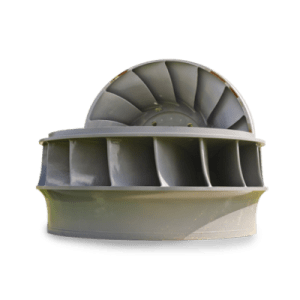Energy
Wind turbine noise: fact or fiction?
Use critical thinking to assess the effects of wind turbine noise.

Overview
Opponents of wind turbines often express concerns about the harmful effects of the low-frequency sound emitted by turbines. In this activity, your students will test their critical thinking skills and demonstrate an intellectual curiosity about how scientifically sound these concerns are.
Instructions
What you'll need
- "Sources on the effects of wind turbine noise" handout (one copy per group of 2-4 students)
- "Assessing scientific soundness" worksheet (one copy per student)
- White board, chart paper, or interactive display
- Project images of the wind turbines at the Moose Lake Wind Project, and briefly explain that while wind power can be a source of clean, renewable, and affordable energy, some people have expressed concerns, especially about negative health effects.
- Guide students in a “popcorn” activity: invite students to quickly suggest possible concerns about wind turbines. At this point in the activity, accept all suggestions. If necessary, remind students that some wind turbines are very close to residential neighbourhoods and farms. Consider noting student suggestions on a white board, chart paper, or interactive display.
- Encourage your students to decide which of the concerns might be the most scientifically sound, and which might not be scientifically sound. As students respond, use their ideas to co-develop or present the criteria for “scientific soundness.” A scientifically sound argument or theory is:
- Evidence-based: builds argument on relevant and reliable evidence
- Consistent with scientific principles: fits with what is generally known to be scientifically true, especially those related to human anatomy and physiology
- Describes cause and effect relationships: clearly describes relationships between causes and effects, especially those related to human anatomy and physiology
- Consider noting the criteria on a white board, chart paper, or interactive display for use later in this activity.
- Invite students to revisit their initial ideas regarding possible concerns about wind turbines in light of the criteria:
- Which might be the most scientifically sound?
- Which might not be scientifically sound?
- Inform students that there are organizations working to stop the development of industrial wind energy facilities (IWEF). Many of these organizations suggest that wind turbine noise (WTN) negatively affects human health. At the same time, other groups argue that WTN does not significantly affect human health.
- Briefly explain that the challenge of this activity is to determine what claims might be the most scientifically sound.
- Organize your students into small groups (2-4 students). Provide each group with a copy of the "Sources on the effects of wind turbine noise" handout, and each student with a copy of the "Assessing scientific soundness" worksheet. Ask groups to assess the scientific soundness of each source using the criteria, and remind them to record any evidence on their worksheets.
- Encourage groups to pay special attention to any evidence related to human anatomy and physiology.
- Prompt groups to share their decisions and supporting evidence with the class. As groups share, invite them to suggest which source presents the most scientifically sound argument for or against wind turbines.
- Conclude the activity by asking students to reflect on their learning:
- Are there other situations or issues where they have encountered scientifically unsound arguments?
- What might they do to ensure their own beliefs and actions are scientifically sound?
Modify or extend this activity
Extension
- Invite students to research and assess the scientific soundness of other health-related claims made about wind turbine noise.
- The criteria for scientific soundness could be used to evaluate the claims made about other forms of energy. Consider having students using the criteria to evaluate claims made about other forms of energy.
Modification
- Consider assigning groups one of the two sources, then inviting groups to compare their ratings.
Curriculum Fit
Science for Citizens 11
Big idea
- Scientific processes and knowledge inform our decisions and impact our daily lives
Content
- Evidence-based decision making through science
- Impact of technologies
- Human impact on Earth’s systems:
- Natural resources
- Effects of climate change
Curricular competencies
Questioning and predicting
- Demonstrate a sustained intellectual curiosity about a scientific topic or problem of personal, local, or global interest
- Make observations aimed at identifying their own questions, including increasingly abstract ones about the natural world
Processing and analyzing data and information
- Seek and analyze patterns, trends, and connections in data, including describing relationships between variables, performing calculations, and identifying inconsistencies
- Use knowledge of scientific concepts to draw conclusions that are consistent with evidence
- Analyze cause-and-effect relationships
Evaluating
- Demonstrate an awareness of assumptions, question information, and identify bias in their own work and in primary and secondary sources
- Consider the changes in knowledge over time as tools and technologies have developed
- Critically analyze the validity of information in primary and secondary sources and evaluate the approaches used to solve problems
- Assess risks in the context of personal safety and social responsibility
Communicating
- Communicate scientific ideas and information, and perhaps a suggested course of action, for a specific purpose and audience, constructing evidence-based arguments and using appropriate scientific language, conventions, and representations
Assessments
Throughout the activity, consider how well students:
- Apply their understanding of the use of evidence and scientific argumentation in determining the degree of soundness.
- Consider issues of safety when reaching conclusions.
- Are able to self-correct and extend their thinking from the beginning of the lesson to the end.
- Pay close attention to appropriate details.
- Use relevant scientific terminology correctly to support their conclusions (e.g., feedback loops, homeostasis, types of external stimuli, accurate use of anatomy when describing systems, interrelatedness of systems).
Teaching Notes
- Read additional background information, from the Government of Canada, on the sound and noise related to industrial wind energy facilities.
- Another perspective on the health effects of industrial wind energy facilities can be found in this article from The Atlantic.







